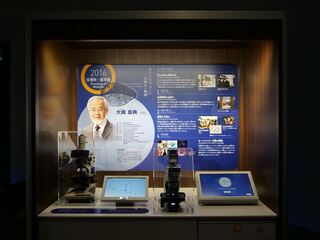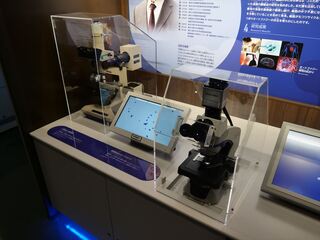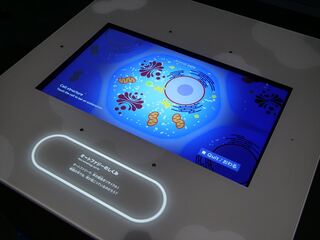Nagoya City Science Museum
TOP > Exhibition Guide > Keyword Search > Starting with "G" > gene > Yoshinori Ohsumi
Yoshinori Ohsumi



Purpose of Exhibition
Living organisms contain many proteins, and each one has a particular function in maintaining life. These proteins are continuously produced and decomposed as they age or break down. When a protein is no longer needed, it is used as the raw material for the production of new proteins. This recycling phenomenon that occurs within cells is called “autophagy.” Dr. Yoshinori Ohsumi was awarded the Nobel Prize in Physiology or Medicine in 2016 for his work in elucidating the mechanism of autophagy using the budding yeast Saccharomyces cerevisiae.
Additional Knowledge
Using an optical microscope, Dr. Ohsumi diligently sought to observe autophagy within a yeast. Since then, many researchers have identified autophagy as a fundamental recycling function of all eukaryotic cells (cells of organisms that have a nucleus in the cell). The discovery of autophagy is expected to contribute to the field of medicine because it is known to be involved in preventing cancer and neurodegenerative diseases.
Dr. Ohsumi and his microscopes
Dr. Ohsumi loved microscopy. On exhibit are the actual optical microscopes that he used when conducting research at The University of Tokyo. This microscope, the Olympus BH2, was a favorite of Dr. Ohsumi because of its excellent performance and ease of use at the time.
What is yeast?
Yeast is a fungus, and in a broad sense it is related to the mushroom. This common ingredient is used for fermentation of bread and beer. Dr. Ohsumi used yeast for his research because it is a very useful organism for studying life phenomena common to many organisms. Yeast is a unicellular organism with a body that is simple to produce, but the contents of this cell are very similar to those of plants and animals. Furthermore, because of this feature, it has long been used by researchers for experimentation, and we now have abundant knowledge of its genetics. We invite you to compare the structure of yeast cells in the exhibit titled “Various Cell Models”
The synthesis and decomposition of proteins
The various proteins at work in the bodies of living organisms are continuously synthesized and decomposed so that their functioning is maintained. Proteins comprise many amino acids, and the types of amino acids and the order in which they are arranged are determined by the genes of the organisms. In other words, when a new protein is created, the amino acids specified by the gene are collected, and they are assembled to create proteins. On the other hand, when autophagy occurs, proteins are decomposed into amino acids that are used to create new proteins. In the exhibit “How autophagy works,” you can witness the process of autophagy.
The Mystery of Autophagy: Cells that Self-consume (2011), Noboru Mizushima, PHP Institute, Inc.
Note: This book was published in the Japanese language. The title is translated for convenience.
